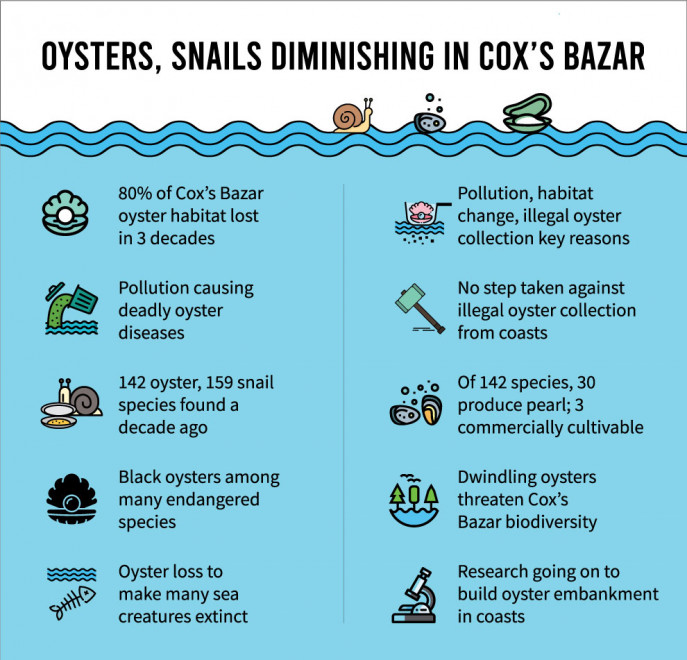'Ecosystem engineer' snails, oysters on the verge of extinction
An oyster purifies 24 to 95 gallons of water every day. There are 142 species of sea oysters and 159 species of snails in the country. Of them 30 species of sea oysters produce pearl

Sea snails and oysters known as the "ecosystem engineers" are disappearing fast from Cox's Bazar due to pollution, habitat destruction, climate change and indiscriminate collection of oysters.
Habitats of as much as 80 percent oysters have been destroyed in the last three decades, scientists say.
"The number of snails and oysters on Cox's Bazar sea beach has come down to less than 20 percent of that found three decades ago," says noted oceanographer, researcher and former district fisheries officer at Cox's Bazar Dr M Kabir Ahmed.

He adds, the environmental balance is getting destroyed due to indiscriminate extraction of stones and oyster from the sea beach.
To worsen the situation, more than 500 metres of land along the coastline in Cox's Bazar sea beach from Kolatoli to Himchhari Pechar Dwip has been lost to the sea in last 28 years due to the erosion caused by the climate change.
According to local people, whereas huge amount of oysters could be seen on the beach from Laboni point to Kolatoli in the past, the present scenario was dismal.
Leaders of environmental organisations in Cox's Bazar said snails and oysters are being collected illegally from the vast sea coast from Cox's Bazar to St Martin's Island. The Department of Environment or any other administrative department has not taken any action to control the illegal activities.
Humayun Kabir, Cox's Bazar divisional (south) forest officer said, they have manpower shortage but they chase the offenders if they get information about illegal oyster collectors.
Hunt for pearl, calcium, shell
Several hundred shops at the Cox's Bazar sea beach sell home decoration pieces made of oyster shells. Goods made of oyster priced from Tk10 to Tk10,000 are available here. Besides, several hundred youths and children sell oyster products throughout the town. Several thousand families are involved with the profession.

In a survey conducted about a decade ago, 142 species of sea oysters and 159 species of snails were identified in the country. Of them 30 species of sea oysters produce pearl. Three species of sea oysters can be cultivated on commercial basis and pearls can be extracted from those.
Dr Md Zulfikar Ali, Chief Scientific Officer at the Marine Fisheries and Technology Station of the Bangladesh Fisheries Research Institute, Cox's Bazar, says there is a natural oyster habitat on the sea coast from the confluence of Bakkhali river in Cox's Bazar town to St Martin's island. Pearl is collected from oysters in the area.
Apart from making ornaments and home decoration pieces, oyster shells are used in poultry and fish feed. Oyster is an important source of calcium for fish and animals. The flesh of oyster is used as feed for shrimp, fish, chicken and ducks. The small ethnic groups across the country eat oyster meat.
Dr Shahadat Hossain, oceanographer and professor at the Marine Science Institute of Chittagong University said, shells of some sea oysters are very rich in calcium. This type of oysters are cultivated in different countries for producing food for humans and producing pearls. There is a scope for earning huge amount of foreign currency by exporting oysters to Japan, Thailand, Malaysia, Sri Lanka and China.
Dr Hossain said the availability of pearl from natural resources is reducing day by day. Oysters are an important element in the aquatic food chain, he said.

Natural water purifiers, beach protectors
Oysters, known as "water purifiers" and "guards of the sea beach," are considered indispensable for protecting the biodiversity in the sea.
Scientists fear that the loss of the oysters will cause the extinction of innumerable life forms in the sea.
About the importance of oysters for the environment, scientists said an oyster purifies 24 to 95 gallons of water every day on an average. It absorbs nitrate and ammonia from water and keeps the water liveable for various organisms.
Oysters habitually create a structure that influences the sea tides, waves and other natural processes. It plays an important role in the formation of seashores by preventing erosion of coastlines. Many sea creatures could not survive if there were no oysters.

Dr Md Shahnewaz Chowdhury, assistant professor at Chittagong University Institute of Marine Science told The Business Standard, one species of oyster can be used to build sustainable embankment in the coastal area.
"With the help of the technology developed by the Dutch scientists we have been researching for the last five years the possibility of creating such embankment in the coastal areas in our country. We have sought assistance from the Netherlands government in this regard," said Dr Shahnewaz.
Scientists said the environment can be protected and livelihood created by farming of oyster.
They said, oysters produce eggs by the end of the spring season and they breed in the water in June and August. Each female oyster lays 75 lakh to 20 crore eggs, but only 1,000 of those survive. Scientists urged all to come forward to protect natural snails and oysters.


 Keep updated, follow The Business Standard's Google news channel
Keep updated, follow The Business Standard's Google news channel
















